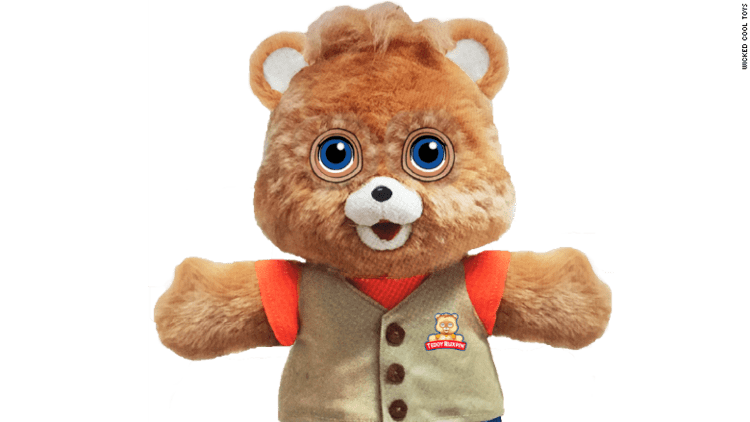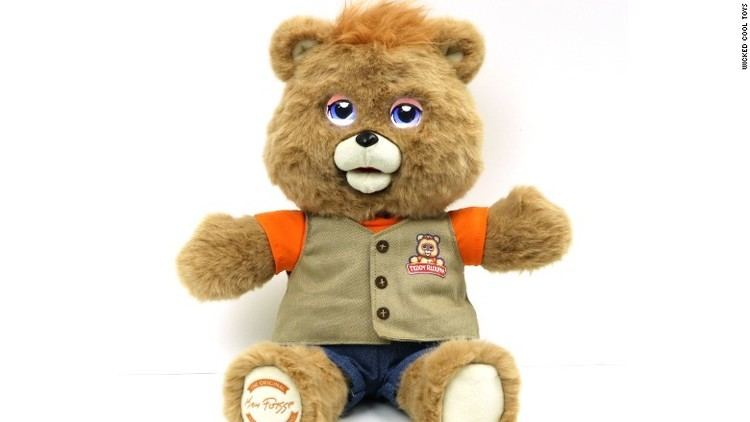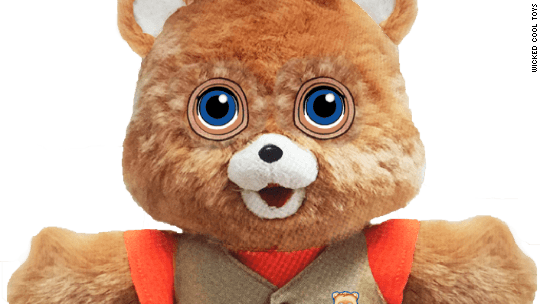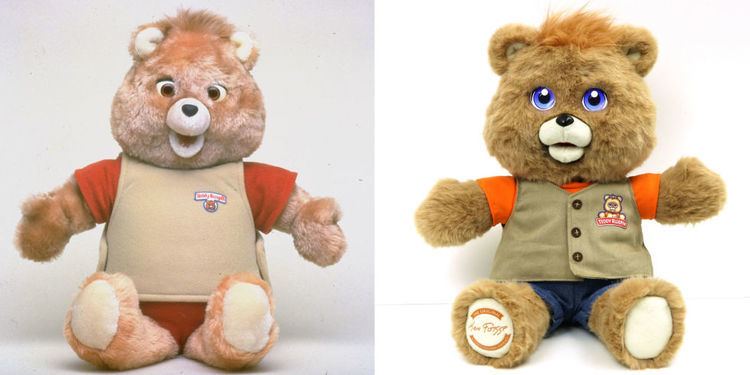Type Teddy Bear Availability 1986–2010 | ||
 | ||
Company Worlds of Wonder (1985–1990)Hasbro (1991–1996)Yes! Entertainment (1998–1999)BackPack Toys (2005–2010)Wicked Cool Toys (2017-?) Slogan The World's First Animated Talking Toy Motto The World's First Animated Talking Toy Similar Sooty, Strawberry Shortcake, Poochie, Humphrey B Bear, She‑Ra | ||
Teddy Ruxpin is an animatronic children's toy in the form of a talking bear. The bear's mouth and eyes moved while "reading" stories that were played on an audio tape cassette deck built into its back. It was created by Ken Forsse with later assistance by Larry Larsen and John Davies, and the first version of the toy was designed by the firm RKS Design. Later versions would use a digital cartridge in place of a cassette. At the peak of his popularity, Teddy Ruxpin became the best-selling toy of 1985 and 1986, and the newest version was awarded the 2006 Animated Interactive Plush Toy of the Year by Creative Child Magazine. A cartoon based on the characters debuted in 1987.
Contents
- The adventures of teddy ruxpin episode 1
- Technology
- History
- Worlds of Wonder
- Playskool
- YES Entertainment
- BackPack Toys
- Worlds of Wonder Original Stories
- Other Cassettes
- Available extra outfits
- Promotions
- Voice actors
- The Adventures of Teddy Ruxpin
- Lawsuits
- References

The adventures of teddy ruxpin episode 1
Technology

Conventional Compact Cassettes carried two audio tracks for stereo sound reproduction. Teddy Ruxpin cassettes used the left track for audio and the right track for a control data stream. The data stream controlled servomotors that moved the eyes and mouth and could also divert the audio signal to Grubby, the companion toy, by means of a proprietary cable. This allowed the two to engage in pre-recorded interactions. Grubby only worked with the initial WOW release of Teddy Ruxpin.

If a conventional audio cassette was played in Teddy Ruxpin, this would be detected and its right audio track would be ignored. Early versions of the toy used three servo motors, but this was reduced to two in later versions.
History
From his debut in September 1985 various toy makers have produced Teddy Ruxpin over the years. The first was Worlds Of Wonder from 1985 until its bankruptcy in 1988. The toy's rights were then sold to Hasbro, and produced again from 1991 to 1996. Another version debuted in 1998 by YES! Entertainment. In 2006, the latest version of Teddy Ruxpin, created by BackPack Toys, debuted.

Shortly after his debut, Teddy Ruxpin was dubbed the "Official Spokesbear for the National Center for Missing and Exploited Children" in 1985.
Worlds of Wonder
Teddy Ruxpin was first produced in 1985 by toy manufacturer Worlds of Wonder. They also released the companion toy Grubby and several other non-animatronic companion toys and characters. This included two different versions of the bird-like Fobs (one orange, one purple) that were hand puppets with a sock-like, extendable neck. Other hand puppets were the larger Wooly What's-It, three interchangeable Anythings (This, That, The Other), Tweeg, and L.B. The Bounder. Other items produced by Worlds of Wonder for Teddy Ruxpin were the Answer Box and Picture Show.
With the strength of its line of toys, Worlds of Wonder’s fortunes rose well beyond its assets. Stock trades by company officers spooked investors. Attempting to stem the tide, WoW issued Non-Investment Grade Bonds, commonly known as junk bonds, in an effort to buoy itself. Although there is some contention as to whether this strategy would have helped, the attempt was made moot by the 1987 stock market crash. Worlds of Wonder filed for bankruptcy protection and was liquidated in 1988. They went through a series of layoffs. The creditors continued to operate the company in receivership until finally closing its doors in late 1990.
Playskool
By 1991 Worlds of Wonder had folded and the remaining assets were liquidated. The Teddy Ruxpin toy line was then picked up by Hasbro, which produced him under their Playskool line until 1996 using the redesign that had been implemented by WoW. This design was smaller and used cartridges that resembled 8-track tapes, instead of cassette tapes. Unfortunately, this cartridge system proved to be easily damaged.
YES! Entertainment
In 1998, Yes! Entertainment brought Teddy Ruxpin back to stores for a third time. The toy's size was largely the same as the Playskool version. Yes! returned to using the standard cassette tapes. This venture was short-lived, however, as Yes! Entertainment's corporate management and financial troubles ultimately resulted in AlchemyII withdrawing the licensing for Teddy. During this production of Teddy Ruxpin, the original Hi-Topps videos were edited and released to work alongside Teddy using the Interactive TV & Video Pack. There was also a small Beanie Baby version of the toy that came boxed with the YES! Teddy Ruxpin in an effort to capitalize on the popularity of Beanie Babies at the time.
BackPack Toys
In 2005, BackPack Toys announced a fourth version of Teddy Ruxpin, which replaced the audio tapes with digital cartridges. Although Teddy Ruxpin is no longer produced by BackPack Toys, some remaining toys and cartridges are available via online retail channels. A new Teddy Ruxpin toys is set for release in 2017.
Worlds of Wonder Original Stories
Worlds of Wonder produced the largest number of stories. They include:
Other Cassettes
Worlds of Wonder created two devices that worked only with Teddy Ruxpin. They were the Picture Show and Answer Box. Neither of these would work with Grubby. The cassettes produced for the Picture Show, which used slide wheels, similar to the View Master were:
The Answer Box cassettes included:
Available extra outfits
Worlds of Wonder made different outfits for Teddy and Grubby. These were sold separately and include:
Promotions
In 1986, during the height of Teddy Ruxpin's popularity, Worlds of Wonder combined with different partners to give safety messages to children. Some of these collaborations included firefighters, as well as the United States Lifesaving Association.
Actress Joanna Kerns served as spokesperson for the toy shortly after its introduction. Kerns herself was at the height of her fame as Maggie Seaver, the family matriarch on the ABC-TV sitcom Growing Pains.
In 1987, Worlds of Wonder contracted with Wendy's restaurants to feature a Teddy Ruxpin themed Kid's Meal promotion. These were similar to the miniatures produced by Worlds of Wonder, except they were smaller and flocked.
Also in 1987, Teddy Ruxpin characters joined the Ice Capades program, which toured the country.
Voice actors
Phil Baron was the voice actor on all tapes and on the TV show, but he left the entertainment industry in the 1990s to become a cantor. Baron is currently the only voice actor officially associated with the property, as Teddy Ruxpin has been the only character in the storyline requiring updated voice recordings for new projects. Will Ryan voiced Grubby in the 1980s and returned as Grubby in the early 1990s for a musical project. The late Tony Pope was the original voice of Newton Gimmick. Pope, as well as other voice actors who provided voice talent for AlchemyII in the 1980s, did not reprise their roles in the television series The Adventures of Teddy Ruxpin because production was moved to Canada; John Stocker replaced Pope as Gimmick for this production. Baron and Ryan have provided the voices of Teddy and Grubby, respectively, in every Teddy Ruxpin incarnation and project since 1985. Ryan also voiced the character of Tweeg in the adventure series but was replaced by John Koensgen for the television series. Additionally, Russi Taylor and Katie Leigh did the voices of Leota the Woodsprite and Princess Aruzia, respectively, on the book-and-tapes, but when the TV series was produced in Canada, Holly Larocque and Abby Hagyard took over the roles.
The Adventures of Teddy Ruxpin
The Adventures of Teddy Ruxpin was a television series that ran from 1987 to 1988. In the series, Teddy Ruxpin leaves his homeland in Rillonia with his friend Grubby in search of adventure. They meet up with an inventor, named Newton Gimmick, who accompanies them on their quest for the Treasure of Grundo. The trio unexpectedly find six crystals with different meanings and powers. These crystals, however, also can enable the Monsters and Villains Organization (MAVO) to have absolute power over the land, and their leader, Quellor, wants to make sure that an Illiop never possesses the crystals. Elsewhere, a less pronounced threat also routinely besieged the trio: the wannabe villain Jack W. Tweeg, a greedy troll/grunge who has his eyes on joining MAVO. The sixty-five episode series unfolds gradually, as the trio meet interesting and often friendly creatures while visiting intriguing lands and going on wondrous, yet wholesome, adventures.
Lawsuits
At least two other companies produced tapes that would work with the Teddy Ruxpin toy. Both Veritel Learning Systems and Vector Intercontinental made Teddy Ruxpin compatible tapes. Worlds of Wonder successfully sued these companies, and the courts ordered the tapes be removed from the market.
